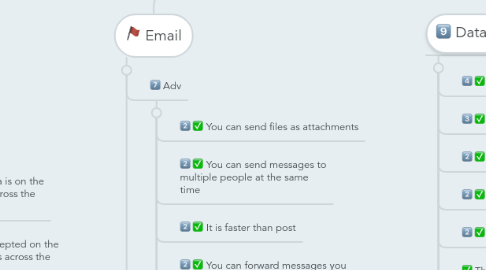
1. transmission methods
1.1. wireless
1.1.1. infrared
1.1.1.1. Adv
1.1.1.1.1. reliable
1.1.1.2. Disadv
1.1.1.2.1. short range
1.1.1.2.2. devices must be in line of sight
1.1.1.2.3. can suffer from interference
1.1.2. microwave
1.1.2.1. Adv
1.1.2.1.1. good for longer distances
1.1.2.2. Disadv
1.1.2.2.1. can suffer from interference from other devices
1.1.3. satellite
1.1.3.1. Adv
1.1.3.1.1. good for very long distances
1.1.3.2. Disadv
1.1.3.2.1. very expensive
1.2. wired
1.2.1. UTP/STP
1.2.1.1. Adv
1.2.1.1.1. interference lessened due to the twisting
1.2.1.1.2. cheaper than other methods
1.2.1.1.3. reliable
1.2.1.2. Disadv
1.2.1.2.1. slow
1.2.1.2.2. low capacity
1.2.1.2.3. used over short distances
1.2.1.2.4. susceptile to noise, which means that the data can be interfered with if near another digital device or signal
1.2.2. Coaxial
1.2.2.1. Adv
1.2.2.1.1. reliable
1.2.2.2. Disadv
1.2.2.2.1. slow
1.2.2.2.2. low capacity
1.2.2.2.3. used over short distances
1.2.2.2.4. thick and physically unflexible
1.2.2.2.5. susceptible to noise
1.2.3. Fibre optic
1.2.3.1. Adv
1.2.3.1.1. fast
1.2.3.1.2. used over long distances
1.2.3.1.3. little interference
1.2.3.2. Disadv
1.2.3.2.1. expensive
1.2.3.2.2. complex to install
2. connection methods
2.1. wireless
2.1.1. Adv
2.1.1.1. not fixed to a stationary computers
2.1.1.2. can be used wherever wireless internet is available
2.1.2. Disadv
2.1.2.1. Needs to have wireless internet available
2.1.2.2. can be less secure than wired
2.1.2.3. tends to be slower than wired
2.2. broadband
2.2.1. Adv
2.2.1.1. better reception and faster than dial-up
2.2.2. Disadv
2.2.2.1. Wired, so has to be used on a stationary computer
2.3. dial-up
2.3.1. Adv
2.3.1.1. can use existing telephone lines, giving connection where broadband is not available
2.3.2. Disadv
2.3.2.1. older technology can give poor reception
2.3.2.2. conversation between digital and analogue signals can cause errors
2.3.2.3. usually slower than other methods
3. Data Exchange
3.1. Packet switching
3.1.1. Adv
3.1.1.1. Sends data across a network efficiently
3.1.1.2. it means big files which would otherwise clog up the network, can be sent whole
3.1.1.3. Allows efficient movement of data through a network because small packets can choose different roots through the network
3.1.1.4. There is a security benefit because if a packet is intercepted, the hacker will only have one part of the whole file
3.1.2. Disadv
3.1.2.1. If one or more packets are lost or corrupted during transmission, the whole file will not be received correctly.
3.1.3. Process
3.1.3.1. Error control bits
3.1.3.1.1. data
4. online services
4.1. communication
4.2. real-time information
4.3. commerce
4.4. goverment
4.5. Education
4.6. VLE
4.7. Business
4.8. Entertainment
4.9. Download service
5. Cloud storage
5.1. adv
5.1.1. You only pay for the storage that you use. You do not have to provide and maintain the hardware
5.1.2. Data can be available anywhere in the world where there is an internet connection
5.2. disadv
5.2.1. It depends on how reliable the host is to access the data
5.2.2. The company may not be using the latest, fastest version of software
5.2.3. You have no control over the files stored and you have ti trust the company to keep them save
5.2.4. The speed of accessing data might be slower than using installed software
6. VoIP
6.1. Adv
6.1.1. Able to contact someone anywhere in the world where there is an internet connection
6.1.2. uses internet-only os no additional cost
6.1.3. reduces travel cost, travel time
6.2. Disadv
6.2.1. relies on internet connection, so it can be a slow connection or it cab cut out
6.2.2. as the audio is being converted to digital, transmitted over the internet connection and converted back agai, the voice quality can be affected
6.2.3. data exchange over the internet is at risk of security threats such as hackers
7. Laws
7.1. Computer Misuse Act 1990
7.2. Copyright Designs and Patents Act 1988
7.3. Freedom of Information Act 2000
7.4. Data Protection Act 1998
8. processing
8.1. client-side
8.1.1. Adv
8.1.1.1. speed - faster because the data is on the client and does not need to move across the internet
8.1.1.2. security - data cannot be intercepted on the client in the way it can when it moves across the internet
8.1.2. Disadv
8.1.2.1. browser-specific - different browsers process scripts in different ways, therefore the web page owner cannot be sure how their web page will appear on the screen
8.1.2.2. computer speed - the web page owner is reliant on the processor speed of the client's computer, so if that is slow then the processing will be slow
8.2. server-side
8.2.1. Adv
8.2.1.1. Efficiency - the information to process does not need to be downloaded to the client's computer
8.2.1.2. Browser independent - It does not matter which browser the user has as the work is done seperatly on the server
8.2.1.3. speed - the processing occurs on the web server , which is likely to be more powerful than a client's computer
8.2.2. Disadv
8.2.2.1. security - when data is transferred across the internet, it is more at risk of security threats
8.2.2.2. overloading - if a lot of users are asking the web server to process data, it could overload the server and cause it to run slowly or crash
9. Email
9.1. Adv
9.1.1. You can send files as attachments
9.1.2. You can send messages to multiple people at the same time
9.1.3. It is faster than post
9.1.4. You can forward messages you have received to other people
9.1.5. You can record contacts in an address book
9.1.6. Webmail providers tend to store emails on a remote provider, meaning that you can access them anywhere via a web browser
9.1.7. You can set a distrbution lists to quickly send to multiple people at the same time
9.2. Disadv
9.2.1. Viruses can be spread through emails
9.2.2. Phising emails may be received
9.2.3. Employees in a business may spend time on their personal email at work
9.2.4. Emails may be intercepted and read by hackers
9.2.5. Spam can be irritating, wasting time and take up space in your inbox
